Effect of Train-Induced Wind on the Transmission of COVID-19: A New Insight into Potential Infectious Risks
Abstract
:1. Introduction
2. Background
2.1. Survey on the Transmission of COVID-19
2.2. Train-Induced Wind
3. Experimental Set-Up
3.1. Moving Model Rig
3.2. Wind Speed Measurements
4. The Wind Speed around the High-Speed Train
5. Assessing the Extent of Wind-Borne Spread of SARS-CoV-2 near the Train
5.1. Gaussian Puff Diffusion Model and Model Implementation
5.2. Scenario of People Standing near the Rail as the Train Pass by
5.3. Wind Condition
5.4. Viral Source
5.5. Aerosol Transport
5.6. Development and Decay
5.7. Deposition
5.8. Result and Discussion
6. Conclusions
Author Contributions
Funding
Institutional Review Board Statement
Informed Consent Statement
Conflicts of Interest
References
- World Health Organization. COVID-19 Weekly Epidemiological Update—June 1 2021; World Health Organization: Geneva, Switzerland, 2021. [Google Scholar]
- Ramirez, G.; Amin, K.; Cox, C. The pandemic’s effect on the widening gap in mortality rate between the U.S. and peer countries. Health Wellbeing 2020, 1, 1–3. [Google Scholar]
- John Hopkins University. Coronavirus Map. Available online: https://coronavirus.jhu.edu/map.html (accessed on 1 June 2021).
- Landi, F.; Carfl, A.; Benvenuto, F. Predictive factors for a new positive nasopharyngeal swab among patients recovered from Covid-19. Am. J. Prev. Med. 2020, 60, 1–7. [Google Scholar] [CrossRef]
- Qiu, Y.; Chen, X.; Shi, W. Impacts of Social and Economic Factors on the Transmission of Coronavirus Disease 2019 (COVID-19) in China. J. Popul. Econ. 2020, 33, 1127–1172. [Google Scholar] [CrossRef]
- Mckee, M.; Stuckler, D. If the world fails to protect the economy, COVID-19 will damage health not just now but also in the future. Nat. Med. 2020, 26, 640–648. [Google Scholar] [CrossRef] [PubMed] [Green Version]
- Gautam, S.; Hens, L. COVID-19: Impact by and on the environment, health and economy. Environ. Dev. Sustain. 2020, 22, 4953–4954. [Google Scholar] [CrossRef]
- Lopez, L.; Rodo, X. The end of social confinement and COVID-19 re-emergence risk. Nat. Hum. Behav. 2020, 4, 746–755. [Google Scholar] [CrossRef] [PubMed]
- Ozkan, T.; Yanglinlar, G.; Kalayci, S. Railway transport liberalization: A case study of various countries in the world. J. Manag. Sustain. 2016, 6, 140–149. [Google Scholar] [CrossRef]
- Jia, J.S.; Lu, X.; Yuan, Y.; Xu, G.; Jia, J.; Christakis, N.A. Population flow drives spatio-temporal distribution of COVID-19 in China. Nature 2020, 582, 389–394. [Google Scholar] [CrossRef]
- Coskun, H.; Yıldırım, N.; Gündüz, S. The spread of COVID-19 virus through population density and wind in Turkey cities. Sci. Total Environ. 2021, 751, 141663. [Google Scholar] [CrossRef]
- Coccia, M. An index to quantify environmental risk of exposure to future epidemics of the COVID-19 and similar viral agents: Theory and practice. Environ. Res. 2020, 191, 110155. [Google Scholar] [CrossRef]
- Avanzato, V.A.; Matson, M.J.; Seifert, S.N.; Pryce, R.; Williamson, B.N.; Anzick, S.L.; Barbian, K.; Judson, S.D.; Fischer, E.R.; Martens, C.; et al. Case study: Prolonged infectious SARS-CoV-2 shedding from an asymptomatic immunocompromised cancer patient. Cell 2020, 183, 1901–1912. [Google Scholar] [CrossRef] [PubMed]
- Meehan, M.T.; Rojas, D.P.; Adekunle, A.I.; Adegboye, O.A.; Caldwell, J.M.; Turek, E.; Williams, B.M.; Marais, B.J.; Trauer, J.M.; McBryde, E.S. Modelling insights into the COVID-19 pandemic. Paediatr. Respirat. Rev. 2020, 35, 64–69. [Google Scholar] [CrossRef] [PubMed]
- Knobler, R.L.; Lampert, P.W.; Oldstone, M.B. Virus persistence and recurring demyelination produced by a temperature-sensitive mutant of MHV-4. Nature 1982, 298, 279–280. [Google Scholar] [CrossRef] [PubMed]
- Rambaut, A.; Pybus, O.G.; Nelson, M.I.; Viboud, C.; Taubenberger, J.K.; Holmes, E.C. The genomic and epidemiological dynamic of human influenza A virus. Nature 2008, 453, 615–619. [Google Scholar] [CrossRef] [Green Version]
- Baker, R.E.; Mahmud, A.S.; Wagner, C.E.; Yang, W.; Pitzer, V.E.; Viboud, C.; Vecchi, G.A.; Metcalf, C.J.E.; Grenfell, B.T. Epidemic dynamics of respiratory syncytial virus in current and future climates. Nat. Commun. 2019, 10, 5512. [Google Scholar] [CrossRef] [Green Version]
- Halloran, S.K.; Wexler, A.S.; Ristenpart, W.D. A comprehensive breath plume model for disease transmission via expiratory aerosols. PLoS ONE 2012, 7, e37088. [Google Scholar] [CrossRef] [Green Version]
- Wang, J.; Tang, K.; Feng, K.; Li, X.; Lv, W.; Chen, K.; Wang, F. High Temperature and High Humidity Reduce the Transmission of COVID-19. Available online: https://ssrn.com/abstract=3551767 (accessed on 30 May 2021).
- Sajadi, M.M.; Habibzadeh, P.; Vintzileos, A.; Shokouhi, S.; Miralles-Wilhelm, F.; Amoroso, A. Temperature, Humidity and Latitude Analysis to Predict Potential Spread and Seasonality for COVID-19. Available online: https://ssrn.com/abstract=3550308 (accessed on 5 March 2020).
- Shi, P.; Dong, Y.; Yan, H.; Zhao, C.; Li, X.; Liu, W.; He, M.; Tang, S.; Xi, S. Impact of temperature on the dynamics of the COVID-19 outbreak in China. Sci. Total Environ. 2020, 728, 138890. [Google Scholar] [CrossRef]
- Srivastava, A. COVID-19 and air pollution and meteorology—An intricate relationship: A review. Chemosphere 2021, 263, 128297. [Google Scholar] [CrossRef]
- Shakil, M.H.; Munim, Z.H.; Tasnia, M.; Sarowar, S. COVID-19 and the environment: A critical review and research agenda. Sci. Total Environ. 2020, 715, 141022. [Google Scholar] [CrossRef]
- Lin, S.; Wei, D.; Sun, Y.; Chen, K.; Yang, L.; Liu, B.; Huang, Q.; Paoliello, M.M.B.; Li, H.; Wu, S. Region-specific air pollutants and meteorological parameters influence COVID-19: A study from mainland China. Ecotoxicol. Environ. Saf. 2020, 204, 111035. [Google Scholar] [CrossRef] [PubMed]
- Frazer, J. Infectious disease: Blowing in the wind. Nature 2012, 484, 21–23. [Google Scholar] [CrossRef] [Green Version]
- Ahmadi, M.; Sharifi, A.; Dorosti, S.; Ghoushchi, S.J.; Ghanbari, N. Investigation of effective climatology parameters on COVID-19 outbreak in Iran. Sci. Total Environ. 2020, 729, 138705. [Google Scholar] [CrossRef]
- Sahin, M. Impact of weather on COVID-19 pandemic in Turkey. Sci. Total Environ. 2020, 728, 138810. [Google Scholar] [CrossRef]
- Wei, J.T.; Liu, Y.X.; Zhu, Y.C.; Qian, J.; Ye, R.Z.; Li, C.Y.; Ji, X.K.; Li, H.K.; Qi, C.; Wang, Y.; et al. Impacts of transportation and meteorological factors on the transmission of COVID-19. Int. J. Hyg. Environ. Health 2020, 230, 113610. [Google Scholar] [CrossRef]
- Coccia, M. The effects of atmospheric stability with low wind speed and of air pollution on the accelerated transmission dynamics of COVID-19. Int. J. Environ. Stud. 2020, 78, 1–27. [Google Scholar] [CrossRef]
- Rosario, D.K.A.; Mutz, Y.S.; Bernardes, P.C.; Conte-Junior, C.A. Relationship between COVID-19 and weather: Case study in a tropical country. Int. J. Hyg. Environ. Health 2020, 229, 113587. [Google Scholar] [CrossRef]
- Eslami, H.; Jalili, M. The role of environmental factors to transmission of SARS-CoV-2 (COVID-19). AMB Express 2020, 10, 1–8. [Google Scholar] [CrossRef] [PubMed]
- van Staden, C. COVID-19 and the crisis of national development. Nat. Hum. Behav. 2020, 4, 443–444. [Google Scholar] [CrossRef]
- Prather, K.A.; Wang, C.C.; Schooley, R.T. Reducing transmission of SARS-Cov-2. Science 2020, 368, 1422–1424. [Google Scholar] [CrossRef]
- Yang, S.; Lee, G.W.M.; Chen, C.-M.; Wu, C.-C.; Yu, K.-P. The size and concentration of droplets generated by coughing in human subjects. J. Aerosol Med. 2007, 20, 484–494. [Google Scholar] [CrossRef] [PubMed]
- Johnson, G.R.; Morawska, L. The mechanism of breath aerosol formation. J. Aerosol Med. Pulm. Drug Deliv. 2009, 22, 229–237. [Google Scholar] [CrossRef] [Green Version]
- Willeke, K.; Baron, P.A. Aerosol Measurement: Principles, Techniques, and Applications; Van Nostrand Reinhold: New York, NY, USA, 1993. [Google Scholar]
- Rocchi, D.; Tomasini, G.; Schito, P.; Somaschini, C. Wind effects induced by high speed train pass-by in open air. J. Wind Eng. Ind. Aerodyn. 2014, 173, 279–288. [Google Scholar] [CrossRef]
- Khayrullina, A.; Blocken, B.; Janssen, W.; Straathof, J. CFD simulation of train aerodynamics: Train-induced wind conditions at an underground railroad passenger platform. J. Wind Eng. Ind. Aerodyn. 2015, 139, 100–110. [Google Scholar] [CrossRef]
- Pope, C. Effective Management of Risk from Slipstream Effects at Trackside and Platforms; RSSB: London, UK, 2008. [Google Scholar]
- Baker, C.J.; Quinn, A.; Sima, M.; Hoefener, L.; Licciardello, R. Full-scale measurement and analysis of train slipstreams and wakes. Part 1: Ensemble averages. Proc. Inst. Mech. Eng. Part F J. Rail Rapid Transit 2013, 228, 451–467. [Google Scholar] [CrossRef]
- Baker, C.J.; Quinn, A.; Sima, M.; Hoefener, L.; Licciardello, R. Full-scale measurement and analysis of train slipstreams and wakes. Part 2 Gust analysis. Proc. Inst. Mech. Eng. Part F J. Rail Rapid Transit 2013, 228, 468–480. [Google Scholar] [CrossRef] [Green Version]
- Dominic, C.F. A Numerical Investigation of the Effect of Crosswinds on the Slipstream of a Model-Scale Freight Train and Associated Effects. Available online: https://etheses.bham.ac.uk/id/eprint/6327/1/Flynn15PhD.pdf (accessed on 26 July 2021).
- TSI 2008. Commission Decision of February 21 2008 Concerning the Technical Specification for Interoperability Relating to the Rolling Stock Subsystem of the Trans-Europen High-Speed Rail System. Technical Report, Official Journal of the European Union, 21 February 2008. Available online: https://eur-lex.europa.eu/LexUriServ/LexUriServ.do?uri=OJ:L:2008:084:0132:0392:EN:PDF (accessed on 26 July 2021).
- CEN. European Committee for Standardization, Railway Applications—Aerodynamics Part 4: Requirements and Test Procedures for Aerodynamics on Open Track; CEN EN 14067-4; CEN: Brussels, Belgium, 2009. [Google Scholar]
- Pii, L.; Vanoli, E.; Polidoro, F.; Gautier, S.; Tabbal, A. A full scale simulation of a high speed train for slipstream prediction. In Proceedings of the Transport Research Arena, Paris, France, 14–17 April 2014. [Google Scholar]
- Baker, C.J.; Dalley, S.J.; Johnson, T.; Quinn, A.; Wright, N.G. The slipstream and wake of a high-speed train. Proc. Inst. Mech. Eng. Part F J. Rail Rapid Transit 2001, 215, 83–99. [Google Scholar] [CrossRef]
- Soper, D.; Baker, C.; Sterling, M. Experimental investigation of the slipstream development around a container freight train using a moving model facility. J. Wind Eng. Ind. Aerodyn. 2014, 135, 105–117. [Google Scholar] [CrossRef] [Green Version]
- Bell, J.R.; Burton, D.; Thompson, M.C.; Herbst, A.H.; Sheridan, J. Moving model analysis of the slipstream and wake of a high-speed train. J. Wind Eng. Ind. Aerodyn. 2015, 136, 127–137. [Google Scholar] [CrossRef]
- Hooper, J.D.; Musgrove, A.R. Reynolds stress, mean velocity, and dynamic static pressure measurement by a four-hole pressure probe. Exp. Therm Fluid Sci. 1997, 15, 375–383. [Google Scholar] [CrossRef]
- RSSB. Guidance on Interface between Station Platforms, Track and Trains; Rail Safety and Standards Board Limited: London, UK, 2017. [Google Scholar]
- TMRR. Technical Management Regulations for Railway—High Speed Railway—Chapter 11: Construction Clearance; China Railway Publishing House: Beijing, China, 2019. [Google Scholar]
- ERA, European Rail Agency. EU Technical Specification For Interoperability Relating to the Rolling Stock Sub-System of the Trans-European High-Speed Rail System (HS RST TSI). Off. J. Eur. Union 2008, 1, 232/EC. [Google Scholar]
- Gil, N.; Baker, C.J.; Quinn, R.A. Passenger train slipstream characterization using a rotating rail rig. J. Fluids Eng. 2010, 132, 1–11. [Google Scholar] [CrossRef]
- Sterling, M.; Baker, C.J.; Jordan, S.C.; Johnson, T. A study of the slipstreams of high-speed passenger trains and freight trains. Proc. Inst. Mech. Eng. Part F J. Rail Rapid Transit 2008, 222, 177–193. [Google Scholar] [CrossRef]
- Khalid, M.O.; Amin, S.; Ahmed, B.; Alouini, M.S. Communication through Breath: Aerosol Transmission. IEEE Commun. Mag. 2019, 57, 33–39. [Google Scholar] [CrossRef]
- Bourouiba, L. Turbulent Gas Clouds and Respiratory Pathogen Emissions Potential Implications for Reducing Transmission of COVID-19. JAMA 2020, 323, 1837–1838. [Google Scholar] [PubMed]
- Hargreaves, D.M.; Baker, C.J. Gaussian puff model of an urban street canyon. J. Wind. Eng. Ind. Aerodyn. 1997, 69–71, 927–939. [Google Scholar] [CrossRef]
- Mohan, M.; Siddiqui, T.A. Analysis of various schemes for the estimation of atmospheric stability classification. Atmos. Environ. 1998, 32, 3775–3781. [Google Scholar] [CrossRef]
- Worldometer. “Coronavirus Update,” Worldometer, 20 November 2020. Available online: https://www.worldometers.info/coronavirus/ (accessed on 20 November 2020).
- Wang, R.M.; Hozumi, Y.; Zheng, Y.H.; Yin, C.; Wei, G.W. Host immune response driving SARS-Cov-2 evolution. Virus 2020, 12, 1095. [Google Scholar] [CrossRef] [PubMed]
- Hoffmann, M.; Kleine-Weber, H.; Schroeder, S.; Krüger, N.; Herrler, T.; Erichsen, S.; Schiergens, T.S.; Herrler, G.; Wu, N.H.; Nitsche, A.; et al. SARS-Cov-2 cell entry depends on ACE2 and TMPRSS2 and is blocked by a clinically proven protease inhibitor. Cell 2020, 181, 271–280. [Google Scholar] [CrossRef]
- Riediker, M.; Tsai, D.H. Estimation of Viral Aerosol Emissions From Simulated Individuals with Asymptomatic to Moderate Coronavirus Disease 2019. JAMA Netw. Open 2020, 3, e2013807. [Google Scholar] [CrossRef]
- Zhang, X.; Ji, Z.; Yue, Y.; Liu, H.; Wang, J. Infection Risk Assessment of COVID-19 through Aerosol Transmission: A Case Study of South China Seafood Market. Environ. Sci. Technol. 2020, 55, 4123–4133. [Google Scholar] [CrossRef]
- Zou, L.; Ruan, F.; Huang, M.; Liang, L.; Huang, H.; Hong, Z.; Yu, J.; Kang, M.; Song, Y.; Xia, J.; et al. SARS-CoV-2 viral load in upper respiratory specimens of infected patients. N. Engl. J. Med. 2020, 382, 1177–1179. [Google Scholar] [CrossRef]
- Wölfel, R.; Corman, V.M.; Guggemos, W.; Seilmaier, M.; Zange, S.; Müller, M.A.; Niemeyer, D.; Jones, T.C.; Vollmar, P.; Rothe, C.; et al. Virological assessment of hospitalized patients with COVID-2019. Nature 2020, 581, 465–469. [Google Scholar] [CrossRef] [Green Version]
- Pan, Y.; Zhang, D.; Yang, P.; Poon, L.L.M.; Wang, Q. Viral load of SARS-CoV-2 in clinical samples. Lancet Infect. Dis. 2020, 20, 411–412. [Google Scholar] [CrossRef]
- Pasomsub, E.; Watcharananan, S.P.; Boonyawat, K.; Janchompoo, P.; Wongtabtim, G.; Suksuwan, W.; Sungkanuparph, S.; Phuphuakrat, A. Saliva sample as a non-invasive specimen for the diagnosis of coronavirus disease: A cross-sectional study. Clin. Microbiol. Infect. 2020, 27, 285.e1–285.e4. [Google Scholar] [CrossRef]
- Zheng, S.; Fan, J.; Yu, F.; Feng, B.; Lou, B.; Zou, Q.; Xie, G.; Lin, S.; Wang, R.; Yang, X.; et al. Viral load dynamics and disease severity in patients infected with SARS-CoV-2 in Zhejiang province, China, January-March 2020: Retrospective cohort study. BMJ 2020, 369, m1443. [Google Scholar] [CrossRef] [Green Version]
- Leung, N.H.L.; Chu, D.K.W.; Shiu, E.Y.C.; Chan, K.-H.; McDevitt, J.J.; Hau, B.J.P.; Yen, H.-L.; Li, Y.; Ip, D.K.M.; Peiris, J.S.M.; et al. Respiratory virus shedding in exhaled breath and efficacy of face masks. Nat. Med. 2020, 26, 676. [Google Scholar] [CrossRef] [Green Version]
- Tang, S.; Mao, Y.; Jones, R.M.; Tan, Q.; Ji, J.S.; Li, N.; Shen, J.; Lv, Y.; Pan, L.; Ding, P.; et al. Aerosol transmission of SARS-CoV-2? Evidence, prevention and control. Environ. Int. 2020, 144, 106039. [Google Scholar] [CrossRef] [PubMed]
- Lewis, D. Mounting evidence suggests coronavirus is airborne—but health advice has not caught up. Nature 2020, 583, 510–513. [Google Scholar] [CrossRef] [PubMed]
- Stadnytskyi, V.; Bax, C.E.; Bax, A.; Anfinrud, P. The airborne lifetime of small speech droplets and their potential importance in SARS-CoV-2 transmission. Proc. Natl. Acad. Sci. USA 2020, 117, 11875–11877. [Google Scholar] [CrossRef] [PubMed]
- Chen, S.C.; Chio, C.P.; Jou, L.J.; Liao, C.M. Viral kinetics and exhaled droplet size affect indoor transmission dynamics of influenza infection. Indoor Air 2009, 19, 401–413. [Google Scholar] [CrossRef]
- World Health Organization. Modes of Transmission of Virus Causing COVID-19: Implications for IPC Precaution Recommendations: Scientific Brief, March 27 2020 (No. WHO/2019-nCoV/Sci_Brief/Transmission_modes/2020.1); World Health Organization: Geneva, Switzerland, 2020. [Google Scholar]
- World Health Organization. Critical Preparedness, Readiness and Response Actions for COVID-19: Interim Guidance, November 4 2020; World Health Organization: Geneva, Switzerland, 2020. [Google Scholar]
- Liu, Y.; Ning, Z.; Chen, Y.; Guo, M.; Liu, Y.; Gali, N.K.; Sun, L.; Duan, Y.; Cai, J.; Westerdahl, D.; et al. Aerodynamic analysis of SARS-CoV-2 in two Wuhan hospitals. Nature 2020, 582, 557–560. [Google Scholar] [CrossRef]
- Doremalen, N.; Bushmaker, T.; Morris, D.H.; Holbrook, M.G.; Gamble, A.; Williamson, B.N.; Tamin, A.; Harcourt, J.L.; Thornburg, N.J.; Gerber, S.I.; et al. Aerosol and surface stability of SARS-Cov-2 as compated with SARS-Cov-1. N. Engl. J. Med. 2020, 382, 1564–1567. [Google Scholar] [CrossRef]
- Kampf, G.; Todt, D.; Pfaender, S.; Steinmann, E. Persistence of coronaviruses on inanimate surfaces and their inactivation with biocidal agents. J. Hosp. Infect. 2020, 104, 246–251. [Google Scholar] [CrossRef] [Green Version]
- Fattorini, D.; Regoli, F. Role of the chronic air pollution levels in the Covid-19 outbreak risk in Italy. Environ. Pollut. 2020, 264, 114732. [Google Scholar] [CrossRef]
- Copat, C.; Cristaldi, A.; Fiore, M.; Grasso, A.; Zuccarello, P.; Santo Signorelli, S.; Conti, G.O.; Ferrante, M. The role of air pollution (PM and NO2) in Covid-19 spread and lethality: A systematic review. Enrion. Res. 2020, 191, 110–129. [Google Scholar] [CrossRef]
- Hirose, R.; Ikegaya, H.; Naito, Y.; Watanabe, N.; Yoshida, T.; Bandou, R.; Daidoji, T.; Itoh, Y.; Nakaya, T. Survival of SARS-CoV-2 and influenza virus on the human skin: Importance of hand hygiene in COVID-19. Clin. Infect. Dis. 2020. [Google Scholar] [CrossRef]
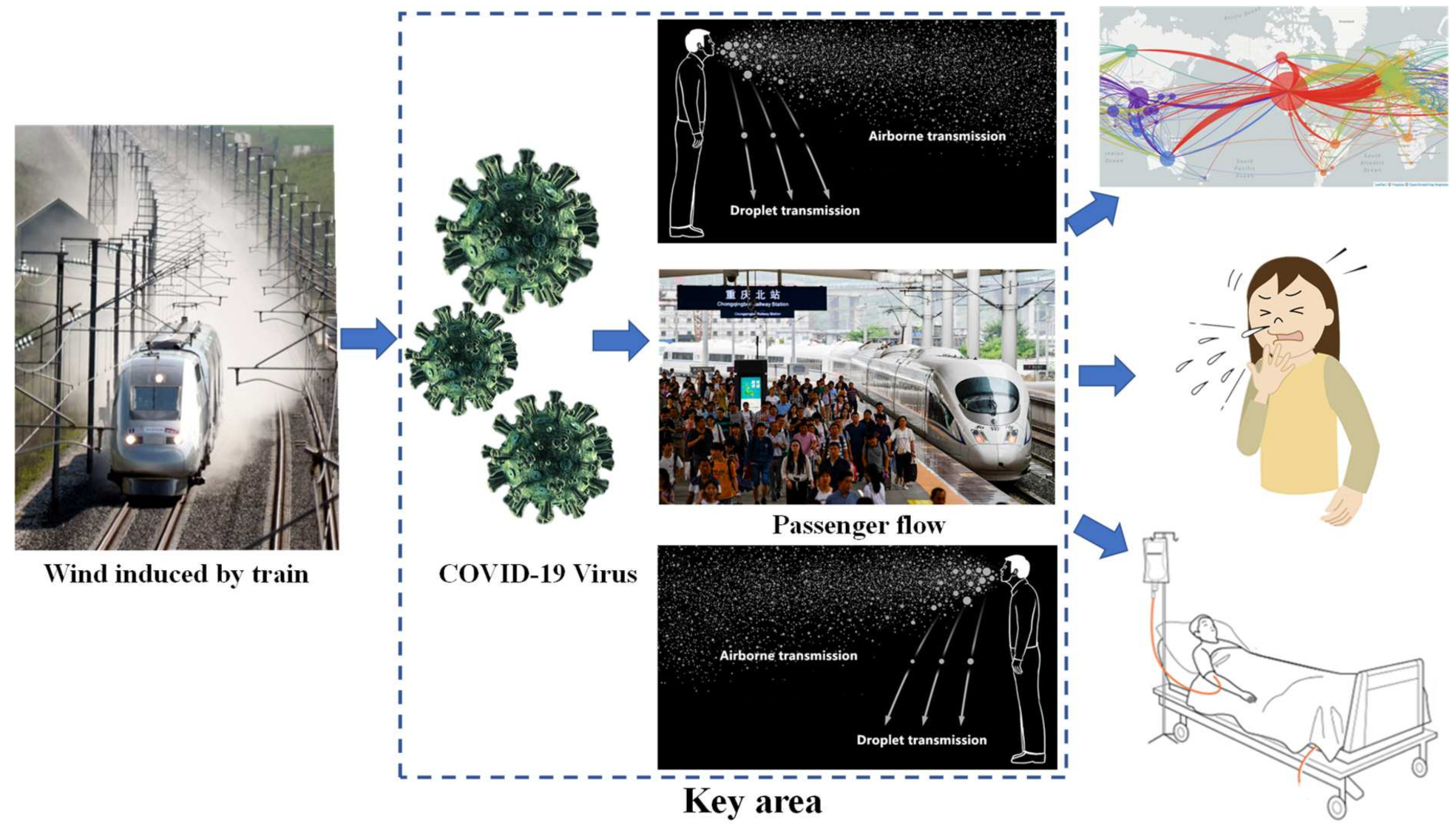
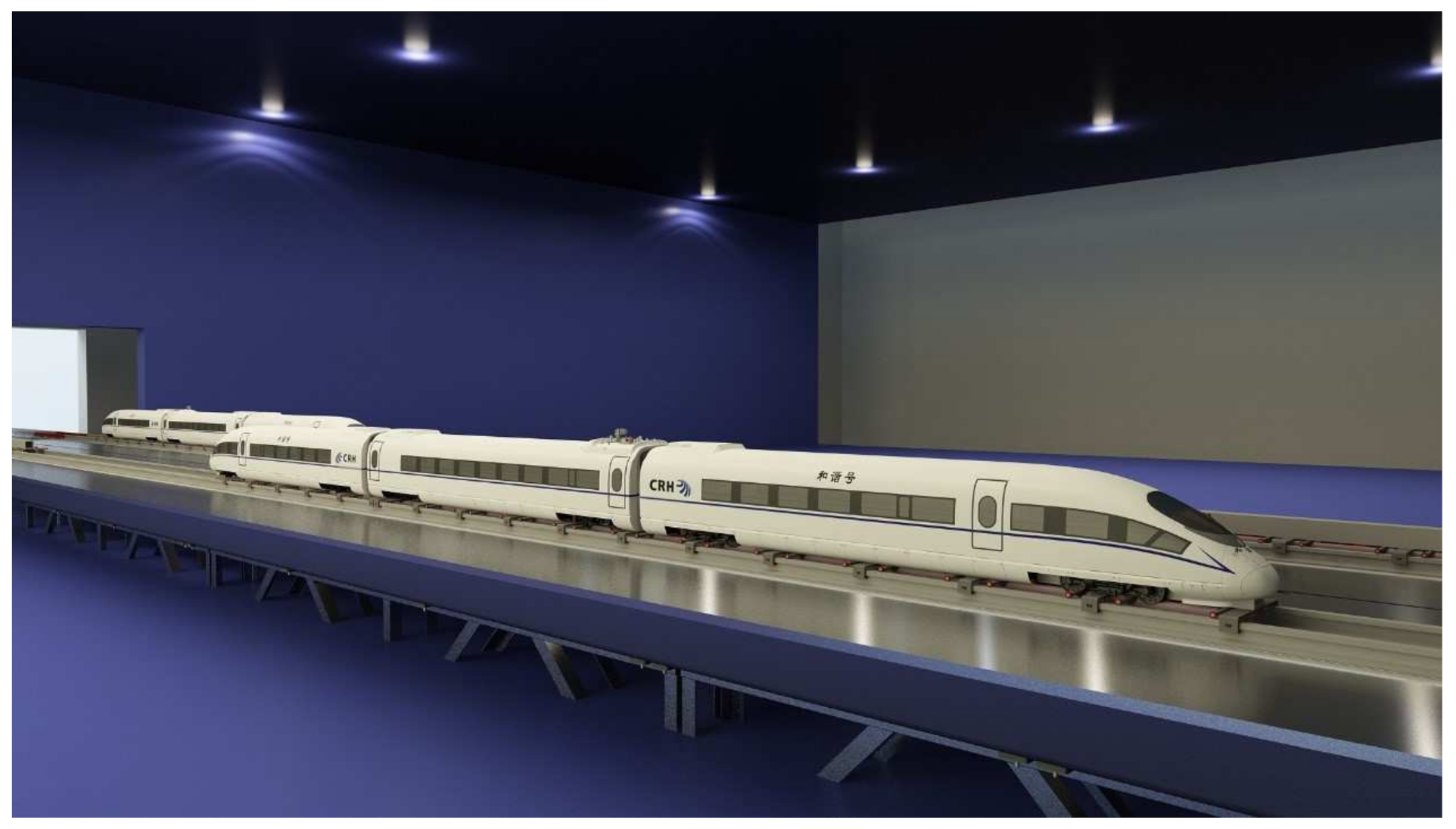
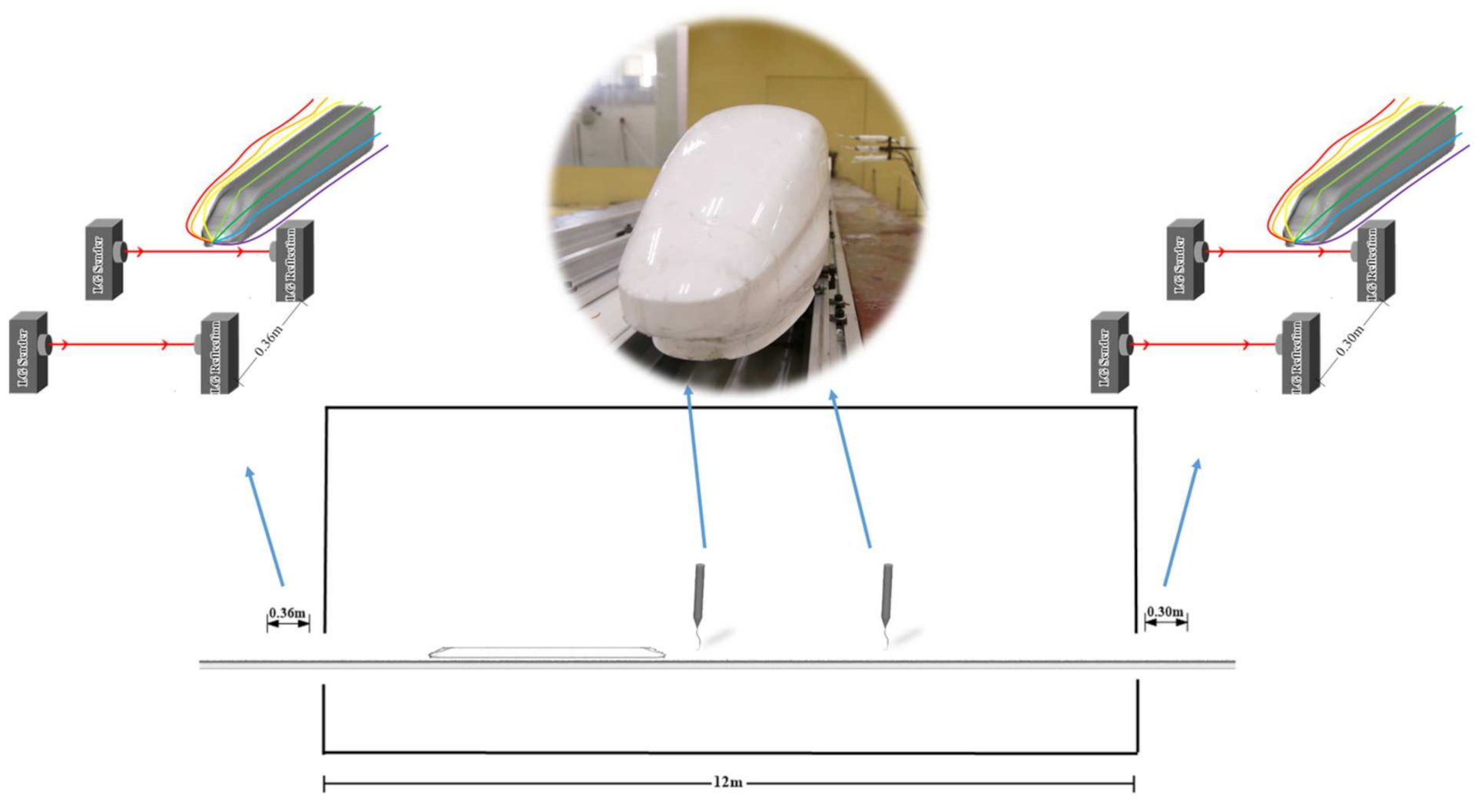
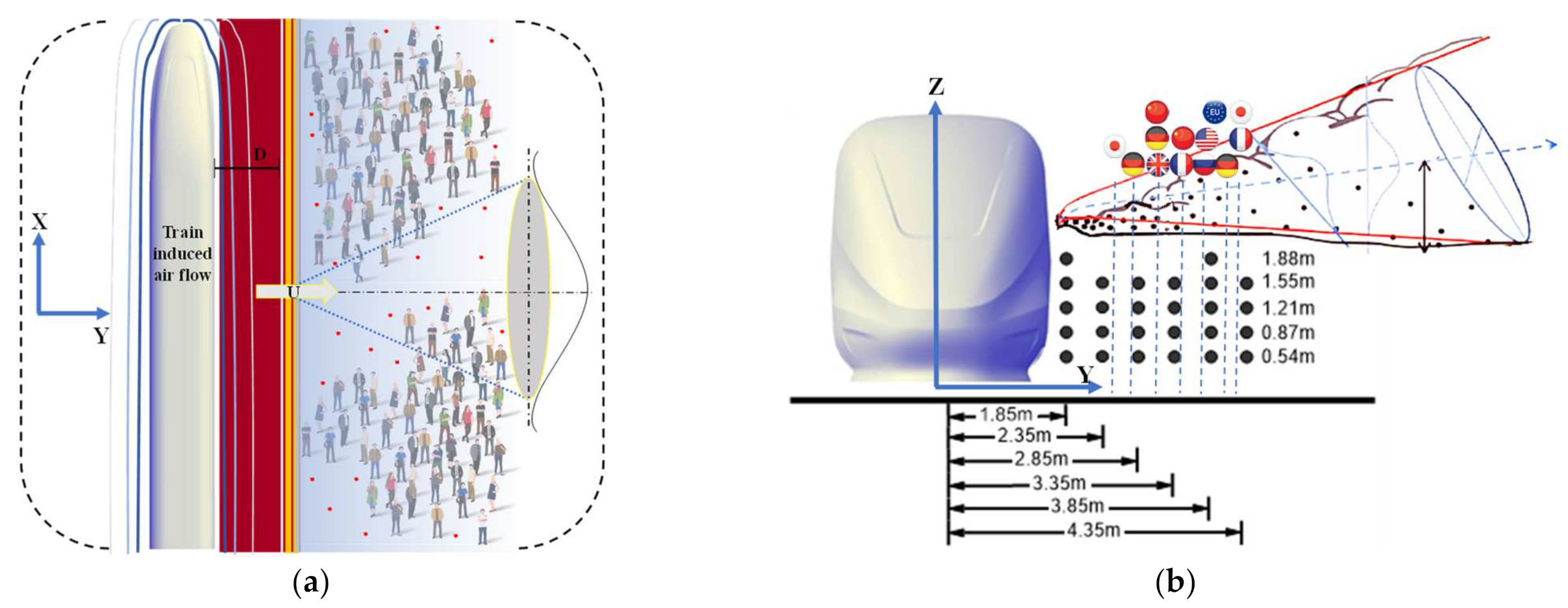
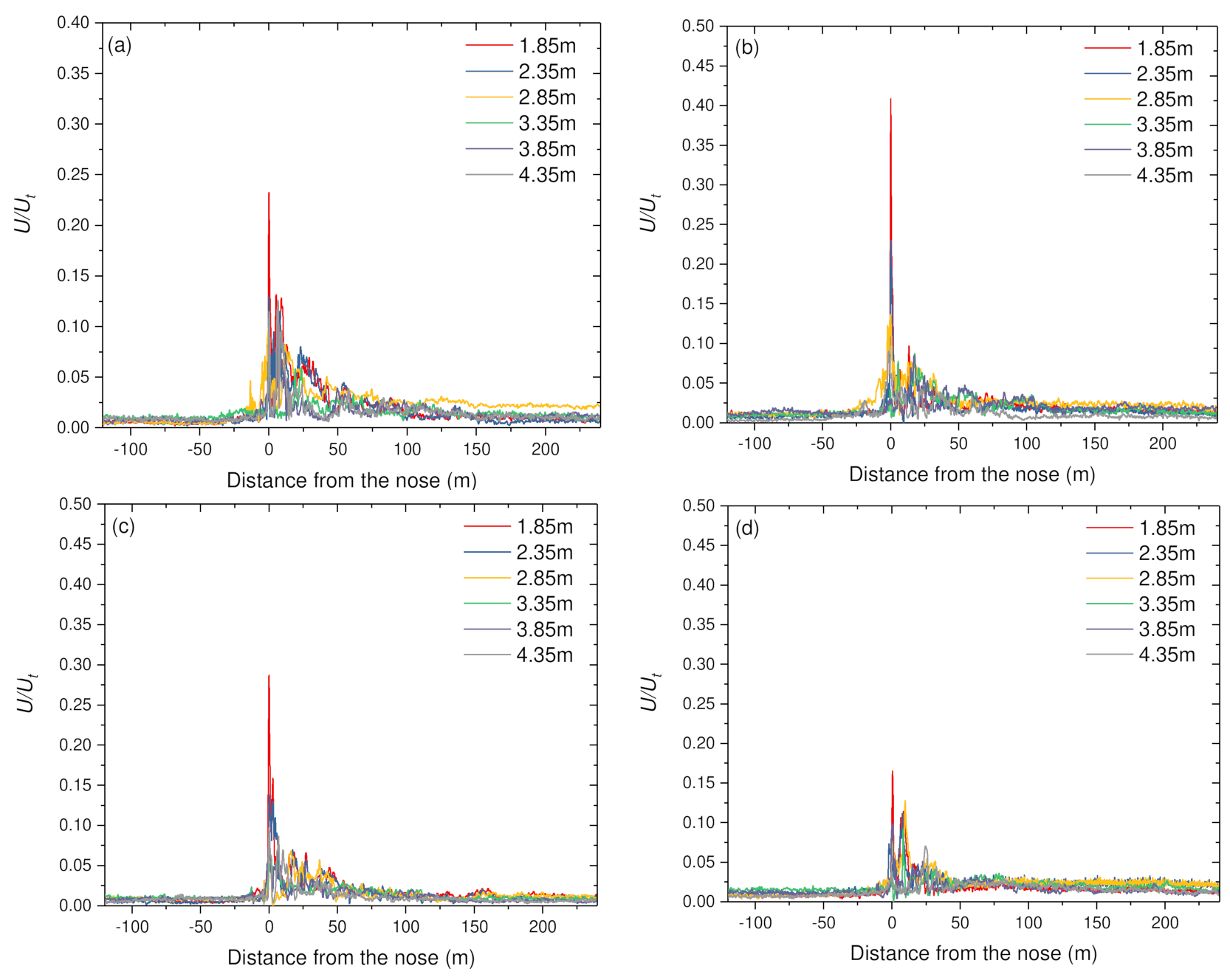
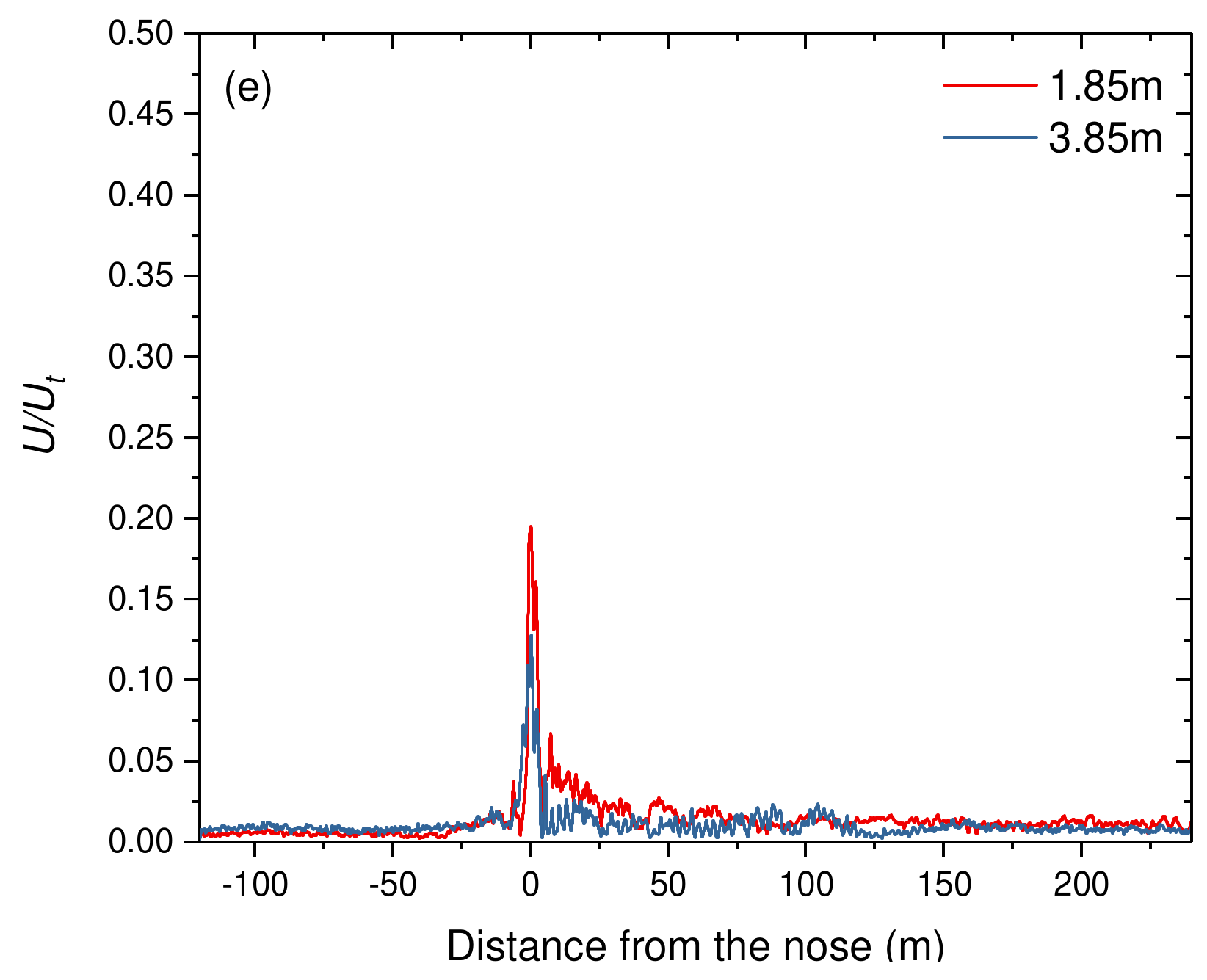
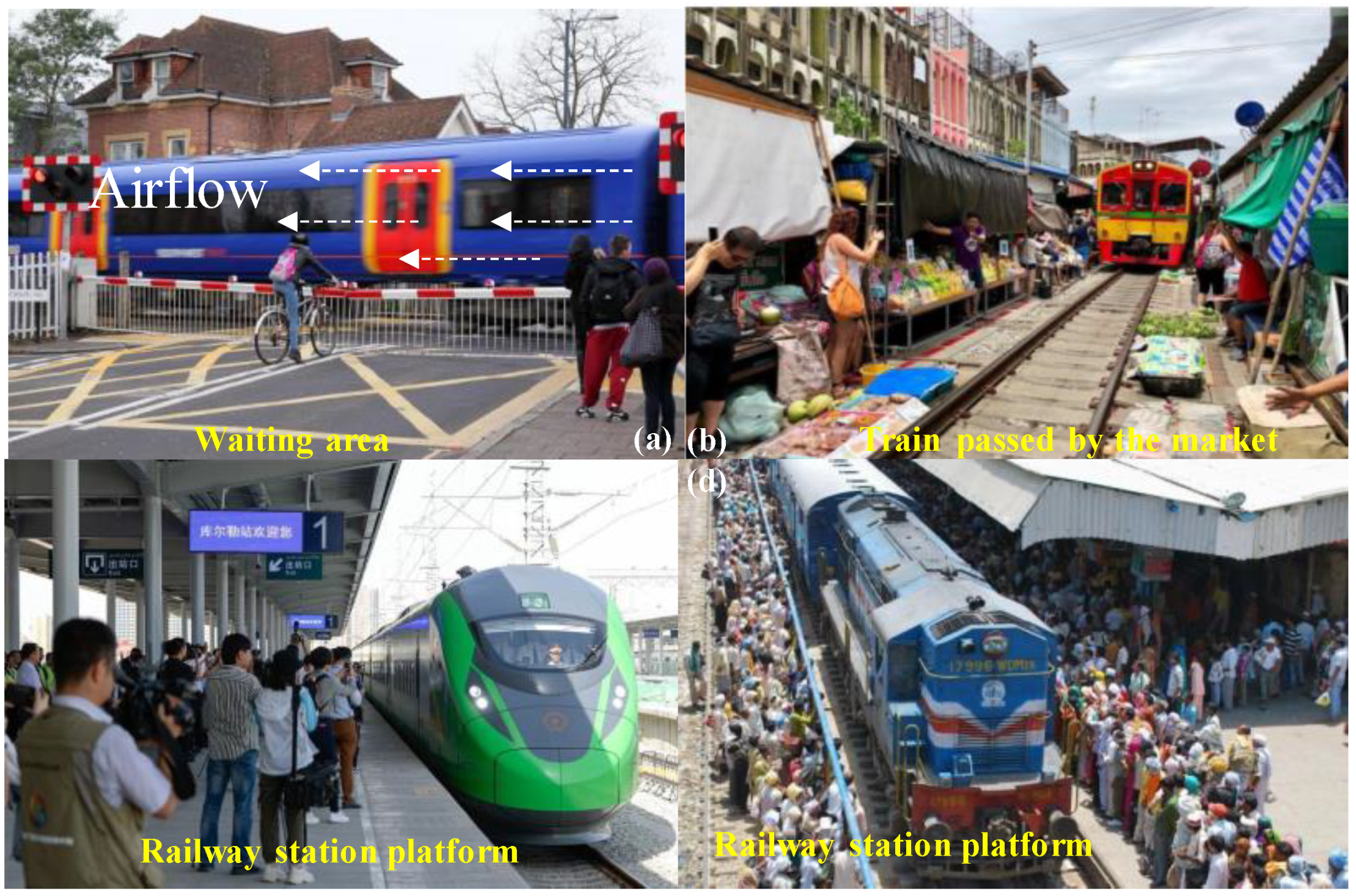
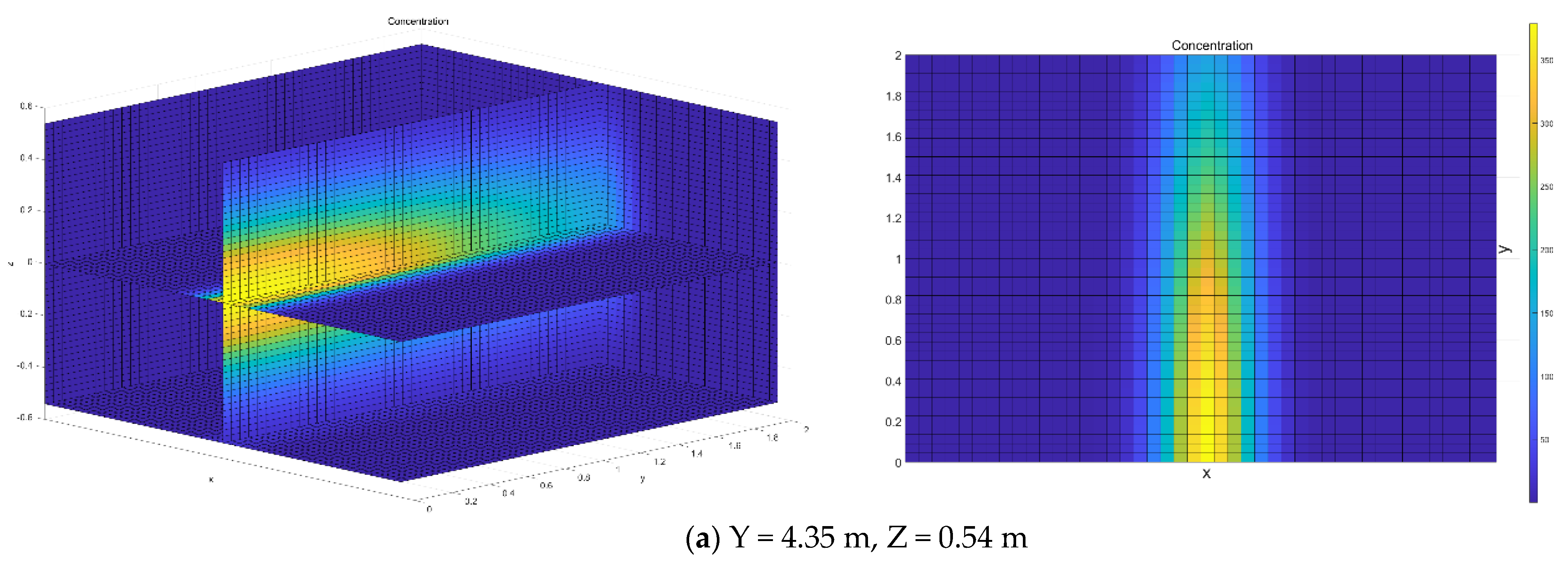
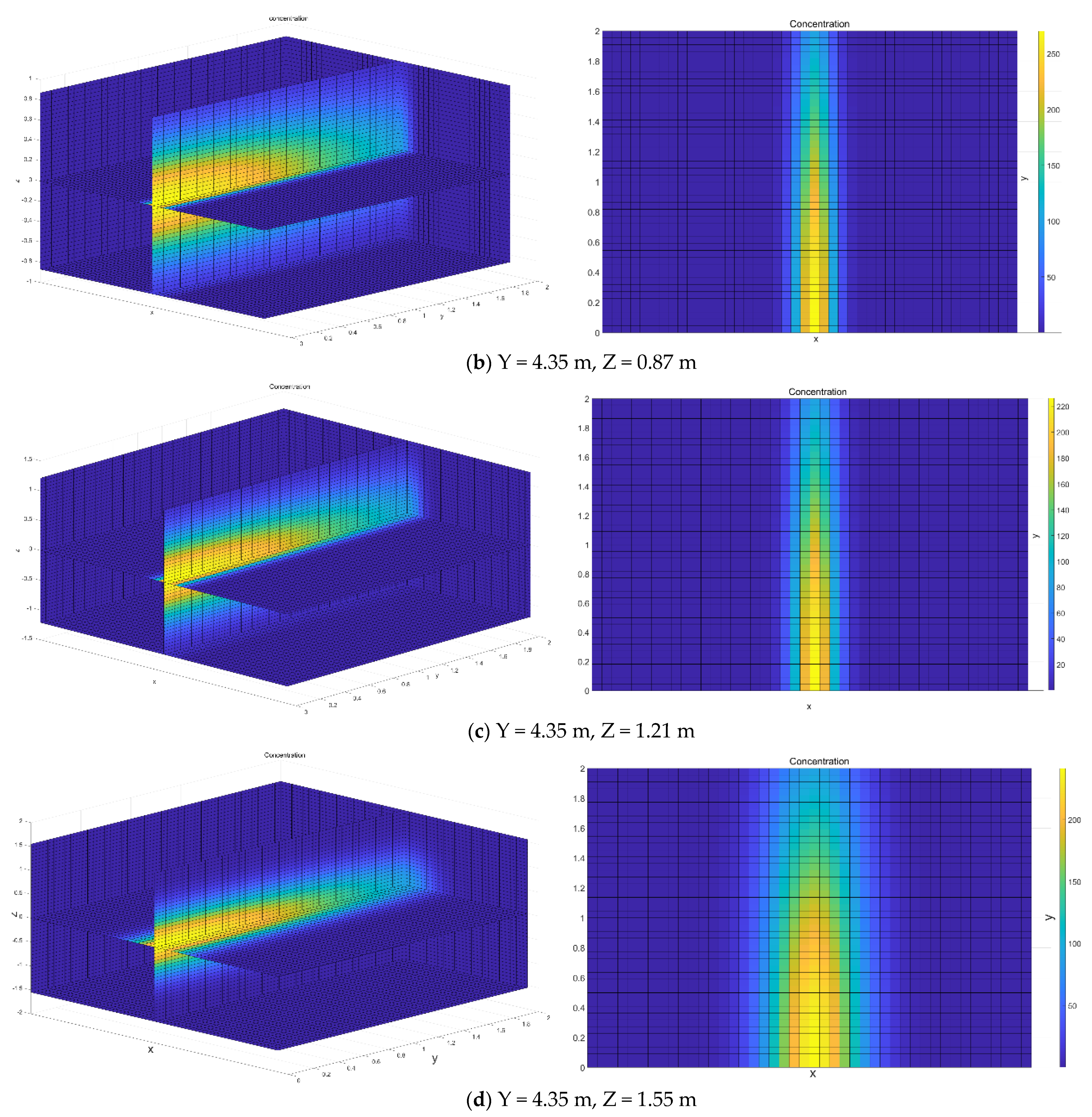
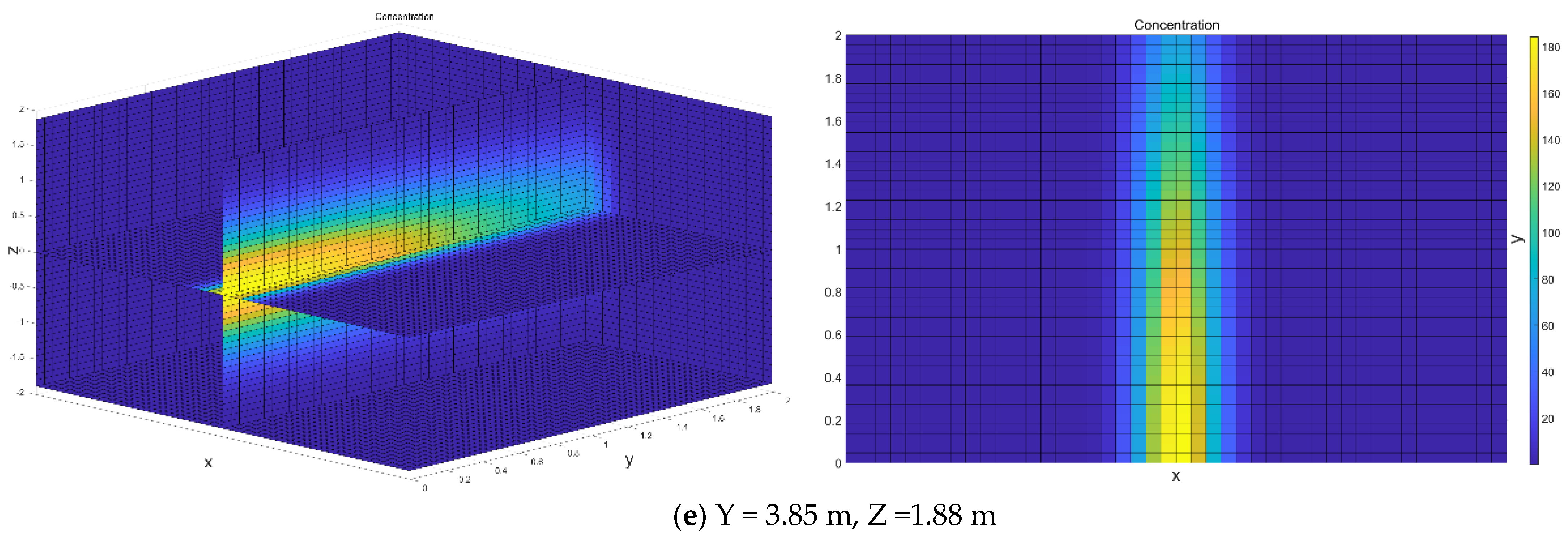
Publisher’s Note: MDPI stays neutral with regard to jurisdictional claims in published maps and institutional affiliations. |
© 2021 by the authors. Licensee MDPI, Basel, Switzerland. This article is an open access article distributed under the terms and conditions of the Creative Commons Attribution (CC BY) license (https://creativecommons.org/licenses/by/4.0/).
Share and Cite
Zou, S.; He, X. Effect of Train-Induced Wind on the Transmission of COVID-19: A New Insight into Potential Infectious Risks. Int. J. Environ. Res. Public Health 2021, 18, 8164. https://doi.org/10.3390/ijerph18158164
Zou S, He X. Effect of Train-Induced Wind on the Transmission of COVID-19: A New Insight into Potential Infectious Risks. International Journal of Environmental Research and Public Health. 2021; 18(15):8164. https://doi.org/10.3390/ijerph18158164
Chicago/Turabian StyleZou, Simin, and Xuhui He. 2021. "Effect of Train-Induced Wind on the Transmission of COVID-19: A New Insight into Potential Infectious Risks" International Journal of Environmental Research and Public Health 18, no. 15: 8164. https://doi.org/10.3390/ijerph18158164
APA StyleZou, S., & He, X. (2021). Effect of Train-Induced Wind on the Transmission of COVID-19: A New Insight into Potential Infectious Risks. International Journal of Environmental Research and Public Health, 18(15), 8164. https://doi.org/10.3390/ijerph18158164





